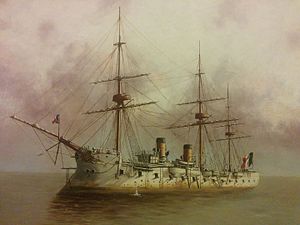 Painting of Duquesne
| |
| History | |
|---|---|
| Name | Duquesne |
| Builder | Arsenal de Rochefort |
| Laid down | 18 June 1873 |
| Launched | 11 March 1876 |
| Commissioned | 20 January 1878 |
| Stricken | 4 December 1901 |
| Fate | Sold for scrap, 2 March 1908 |
| General characteristics | |
| Class and type | Duquesne class |
| Displacement | 5,824 t (5,732 long tons; 6,420 short tons) |
| Length | 99.64 m (326 ft 11 in) |
| Beam | 15.56 m (51 ft 1 in) |
| Draft | 7.14 m (23 ft 5 in) |
| Installed power |
|
| Propulsion |
|
| Sail plan | Full ship rig |
| Speed | 16.85 knots (31.21 km/h; 19.39 mph) |
| Range | 6,680 nautical miles (12,370 km; 7,690 mi) at 10 knots (19 km/h; 12 mph) |
| Complement | 551 |
| Armament |
|
Duquesne was an unprotected cruiser built for the French Navy in the 1870s, the lead ship of the Duquesne class. She was ordered in the aftermath of the Franco-Prussian War, and was intended for use against commerce raiders, which necessitated a high top speed, heavy armament, and long cruising radius. The ship's engines proved to be very unreliable, and coupled with the high cost of operating the vessel, she proved to be a disappointment in service. As a result, she saw limited use; she had one major overseas deployment in the mid-1880s, during which time she cruised in the Pacific Ocean. She operated with the Atlantic Division in 1894 and 1895, but saw no further service. She was struck from the naval register in 1901 and was sold for scrap in 1908.